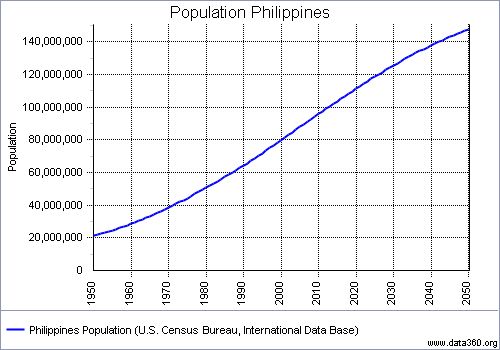The RH Bill and Exponential Growth
In my article What the Debate on the RH Bill Should Not be About, I argued that overpopulation is a non-issue in debates over the passage of the RH Bill. There I reasoned that the battle over the RH Bill is a women’s rights battle and that overpopulation has little if anything to do with it. While I am still convinced that the RH Bill is a women’s rights issue, the following observations forced me to reconsider the relationship between the bill and the Philippine population problem:
- The world population has exceeded 7 billion. What’s worse is that it shows no signs of stabilizing on its own anytime in the foreseeable future (contrary to the claims of the laissez-faire advocates).
- The successful population management measures in many countries around the world, particularly in neighboring Thailand and Vietnam, have yielded very positive effects. In fact, the said countries have already overtaken the Philippines in terms of social and economic progress.
- Our legislators, particularly Senator Sotto, continue to use overpopulation denial myths as arguments against the passage of the RH Bill.
- Conservative estimates have pegged the Philippine population at 101 million as of July 2011.[1]
- The Philippine population grew by 1.904% in the year 2011.[1]
The above observations should be enough to convince any rational person that the RH Bill is not only important but is urgently needed. Sadly, many of our politicians aren’t really of the rational sort.

Sotto Voce?
On a Senate interpellation on the RH Bill held last December 5, Senator Tito Sotto parroted the same old ridiculous arguments that supposedly prove that the world is not overpopulated. Worse still, Sotto went as far as to claim that the world would never experience overpopulation. In his own (?) words, “These people think that they are smarter than God. Sa tingin ba nila gagawa ba ang Diyos ng mundo na mapupuno? [Do they think God will create a world that will be overpopulated?]”

Sotto’s argument is blatantly invalid in two ways. First, it is legally invalid; such a theological argument has no place in a secular interpellation (and that goes for you too, Senator Miriam Santiago). The fact that such a theological argument can be used in a Senate interpellation without drawing any objections from the other senators is enough to give any secularist a conniption. Second and perhaps worse, Sotto’s argument is logically invalid; it does not follow that if there is a god, then that god will create a world that will never be overpopulated.
Setting aside the invalidity of his arguments, Sotto’s claim that the Philippines will never be overpopulated is also demonstrably, disturbingly and dangerously false. The key to debunking Sotto’s absurd claim is contained in just two words: exponential growth.
Three Chinas in a Philippines
This year, the Philippine population experienced a growth of 1.904%. If this population growth rate is maintained, the Philippine population will double in a mere 36 years and 9 months – around 37 years.[2] If there are 101 million Filipinos alive today, that means there will be 202 million Filipinos alive 37 years from now. Give another 37 years (that’s 74 years from now) and there will be 404 million Filipinos alive. Fast-forward to another 37 years (111 years from now) and our population is already at 808 million; by then our population is rapidly speeding toward the 1 billion mark. Does this pattern sound familiar? Why of course, it is nothing but the geometric progression that we’ve met in Part 1 of this article. By now you should know that if our population keeps on growing in such a pattern, then we’re in for a lot of trouble.
Shown below is a table of the projected population of the Philippines in the next two centuries under the assumption that our population growth rate remains steady at 1.904%.
| Table 1 | |
| Year | Population |
| 2011 | 101 million |
| 2048 | 202 million |
| 2085 | 404 million |
| 2122 | 808 million |
| 2159 | 1.616 billion |
| 2196 | 3.232 billion |
Under this steady growth rate scenario, the Philippine population would exceed 1 billion somewhere around the year 2130. Our great grandchildren, perhaps even some of our grandchildren, would still be alive at that time and would be among the 1 billion Filipinos trying to fit inside a country 32 times smaller than China. By the end of the 22nd century, the number of people trying to fit inside the Philippines is more than thrice the number of people living in China today. By the year 2500 the Philippine population is already, quite simply, astronomical. Now matter how look at it, the Philippines can be overpopulated and it will be overpopulated if we will do nothing about our population growth rate. Take that, Tito Sotto.
The Philippine Population Growth Rate: Good News and Bad News
Three objections can be leveled against the previous hypothetical scenario. The first one goes like this: Malayo pa naman ang taong 2196 ah, bakit natin po-problemahin yun? [The year 2196 is still many, many years away, why should we bother about what’s going to happen then?] The degree of myopia implied by this objection is, sad to say, exhibited by many of our politicians and citizens. This can be remedied only by good moral education. But this remedy takes a long time, perhaps several generations. We need to act on the problem now. The only way to expedite the solution is to replace our myopic politicians with wise, far-seeing leaders. For this purpose we have the democratic process of voting our future leaders.
The second objection is worse than the first: Malapit namang magugunaw ang mudo. Bakit pa tayo magpapakahirap sa pag-ayos nito? [The world is going to end soon anyway. Why waste your effort making it a better place?] Unfortunately, many people, some of them even intelligent, sincerely hold this view that the world is ending soon. It is our job as freethinkers and as people who love the earth to think of creative ways to convince these people to care for the future of our planet. We might need to convert them to freethought or to more liberal versions of their religion. We might also try to convince them that if they believe that the god they love created this world, then they should do everything to take care of it. Whatever our strategy is, we must do everything we can to decrease the number of people who believe the world will end soon because if we don’t, then it surely will.
The third objection is a rational one: The steady growth rate scenario is an oversimplification because the Philippine population growth rate isn’t really constant but is in fact decreasing. This objection is in fact valid. (It does not, however, negate the fact that the scenario in the previous section disproves Tito Sotto’s claim that the world will never be overpopulated.) Official records show that the Philippine population growth rate has been on a general trend of decline over the past decades. The Philippine population growth rate over the past few years is shown in the table below. [3]
| Table 2 | |
| Year | Population Growth Rate |
| 1970 | 3.08% |
| 1980 | 2.71% |
| 1990 | 2.35% |
| 2000 | 2.36% |
| 2007 | 2.04% |
There is good news and bad news in the trend of the population growth rate.
Let’s begin with the good news. The decline in our population’s growth rate is either an effect or an indicator of the following:
- Our government’s previous family planning programs have been, to a certain extent, effective.
- Filipino women have been slowly gaining empowerment over the past decades.
- The Filipino youth have been slowly gaining accurate RH information in recent years.
- Philippine cultural values have shifted from the valuing the quantity of life to valuing the quality of life.
- The Church’s anti-contraceptives stance is quickly losing support among Filipinos.
Now off to the bad news. I will first state them in somewhat technical language. Later I will unload them in layman’s language. Here they go:
- While fertility rates have been steadily declining in middle- to high-income families, the fertility rates in low-income families have not dropped; in fact, studies show that they have increased in the period between 1997 and 2000(see Reference [7]).
- The disparity between our country’s fertility rate (somewhere between 2.79 and 3.19[4]) and population growth rate (1.904%) is an indication that there remains a high infant mortality rate in the Philippines.
- The decline in our population growth rate is better modeled by a decreasing exponential and not a decreasing linear plot.[5]
Now let us explain the bad news in layman’s language one by one.
First bad news: Families with means voluntarily undergo family planning while poor families continue to have more babies than they can feed. (But who doesn’t know this already? Apparently the anti-RH camp.) So even though the population growth rate of the Philippines is declining on average, the decline is not uniform across all income levels. This causes the top of the social pyramid to become thinner and the base to become wider. If this keeps on going, this means that in the near future our society will be composed of fewer and fewer people with means and more and more people who cannot feed their families. (Wait, am I describing the future here or the present?) An economist of any feather will tell you that this is really bad news.

Second bad news: If there are many children born for every woman in the Philippines, then why is our population not growing as rapidly as it should? Surely this is not because of an increased natural death rate; our natural death rate is in fact declining. The only explanation available is that many infants are dying. High infant mortality rate is an indication of high birth rates among low-income families. That brings us back to bad news number one.
Third bad news: Yes, our population growth rate is decreasing, but its rate of decrease is slowing down over time. This means that as years go by, it won’t decrease fast enough to curb our growing population. For example, by year 2100, our population growth has decreased but is still at 1.52%. That’s 89 years from now when our population growth rate is at 1.904%! End story: our population will keep on growing exponentially if we do nothing about it. The decline in population growth rate is not enough to curb the exponential population growth that has been going on for decades now.
The graph below shows the projected Philippine population in the coming decades as assessed by the U.S. Census Bureau. According to the graph, the Philippine population will be at 150 million in the year 2050. Note that this projection is around 75% of the value projected in Table 1 for the year 2048.

Lessons From the Losing CEO
If we learned anything from Part 1 of this article, then it is that one should never underestimate the power of exponential growth. We are therefore faced with the following fact: Our population is already at 101 million and it continues to grow exponentially. Even if our population growth rate is declining, it is not declining fast enough to curb the dangerous rise in our numbers. Worse still, studies show that while families with means tend to have fewer children, poor families tend to have many.
But we’ve seen that there’s good news. As long as you give families and especially women the freedom to choose, they will choose to keep their family size manageable. This is shown by the significant decrease in the fertility rates among middle to upper class women over the past decades. Poor families and poor women in particular, however, still do not have the means and the freedom to choose the family planning method that suits them best. This explains why the fertility rate among low-income families remain dangerously high. All the facts indicate, however, that if we give them the power to choose, low-income families will voluntarily plan families of manageable sizes (1-4 children). Note that they will do this for their own good without knowing that they are, in effect, helping to solve a national problem.
Herein lies the magic of the RH Bill: It solves two different problems in one stroke. On the one hand, it will give poor families the power of options in planning their family. On the other hand, its end effect will be the curbing of our population growth. The RH Bill will do these and more. At the most basic level, the RH Bill will give women their basic rights to family planning services and it will give the youth their basic rights to scientific and age-appropriate education.
The RH Bill: An Urgent National Concern
Never forget that one does not kid with exponential growth. If we are to secure our future as a country, then we must manage our population now. In fact, we should have started decades ago.
Congress and Senate must pass the RH Bill by January of next year, or else it will be too late. Remember, we are racing against time in our battle against the most powerful force in the universe.

* * *
Notes:
[1] Taken from the webpage of index mundi, Reference [4]. See also References [5] and [6] for official data.
[2] The equation for any kind of exponential growth is similar to that of compound interest: FV = PV(1 + i)n. Here, FV is the future value (of an investment or of a population), PV is the present value, i is the rate of increase and n is the number of times the value is increased. In our case, PV is 101 million, the present population of the Philippines. If it doubles, this means that FV is 202 million. Meanwhile, i is 1.904% = 0.01904, the population growth rate. We want to solve for n, the number of years it takes for PV = 101 million to become FV = 202 million. This is accomplished by dividing both sides of the compound interest equation by PV, then taking the logarithm of both sides and then finally using the properties of logarithms. The solution is going to be n = 36.75.
[3] See References [5] and [6] for the official estimates. Reference [4] provides more recent, unofficial estimates. Reference [8] provides projections based on UN studies.
[4] The high estimate is from Reference [4], the low estimate is from Reference [8].
[5] The best fit exponential curve in the population growth rate has an equation of f(x) = (2×10-7)e-0.01x with coefficient of determination R2 = 0.935. I tried the best-fit linear curve, and its coefficient of determination is only at R2 = 0.932; even then, the slope of the linear trend line is negligibly small so that difference between the predictions of the linear plot and those of the exponential plot will not be very great.
* * *
References:
[1] Miller, G. Environmental Science, 10th ed, 2005.
[2] Campbell, N.A., Reese, J.B. and Mitchell, L.G., Biology, 5th ed, 1999.
[4] Index Mundi. <http://www.indexmundi.com/philippines/population_growth_rate.html>, accessed 15 December 2011.
[5] National Statistics Coordination Board. <http://www.nscb.gov.ph/secstat/d_popn.asp>, accessed 15 December 2011.
[6] National Census Data via the National Statistics Office. <http://www.census.gov.ph/data/sectordata/popproj_tab1r.html>
[7] Asian Development Bank, Poverty in the Philippines: Income, Assets and Access. 2005.
[8] Costello, M.P. and Casterline, J.B., Fertility Rate Decline in the Philippines: Current Status, Future Prospects. 2005


The points you make here about how population always increases faster than resources seem to be little more than a rehash of the discredited theories of accused plagiarist Thomas Malthus. I wrote a piece last year which refuted many of the conclusions about the “population bomb” and “overconsumption”. You can find it at http://romuloadvocate.wordpress.com/ under “The Philippines: Underdeveloped But Not Overpopulated”.
That being said, I also have to point out the irony in the “Occupy for RH” initiative in a bunch of leftists and others organizing support for a population control policy that was put together by the same bunch of racist, neocolonialist, “capitalist” oligarchs that they claim to oppose. (Although some RH supporters apparently refuse to acknowledge the well-documented existence of clandestine initiatives to keep post-colonial nations backward and underdeveloped; brushing it off as “conspiracy theory”.)
One really has to ask: Of all the extremely urgent economic problems confronting both the Philippines and the world to organize an “Occupy” movement around, why choose the red-herring non-issue of the RH Bill? Anything legitimate within the legislation could and should be repackaged as part of a more comprehensive and effective “New Deal-style” emergency economic policy—which this country desperately needs.
It would seem to me that the real main cause of this nation’s economic and social woes is the erosion of her sovereignty and the unpayable mass of external debt. Why not instead demand that the Philippine government follow the example set by Argentina, and declare a moratorium on all the onerous and illegitimate debts that have caused her to sacrifice the welfare of her people for the sake of meeting her obligations? Is that not a more worthy cause to rally mass support around?
If one really looks at the RH Bill and its related issues thoroughly and honestly, it will become evident that A.) the proposal isn’t gonna do a damn thing to alleviate poverty or make Filipino society more egalitarian and B.) is intended by neo-eugenicists to be an entry-level phase toward the implementation of more aggressive and more fascist population control measures.
A reply to your first paragraph: I read your article and it told me that there is a lot that you do not know about the relationship of the environment and human population. To mention but a few of your inadequacies, you are particularly ignorant of the concept of ecological carrying capacity, biocapacity and ecological footprint. Your cavalier dismissal of sustainable development, to give another example, is a sign that you hold views on progress that are unwise beyond measure. For that, I request you to wait for my upcoming articles that will show that (1) the Philippines is already overpopulated at 101 million, (2) the world is already overpopulated at 7 billion and (3) that sustainable development is the most logical means of achieving real progress as a nation and as a civlization.
A reply to the rest of your comment (with the exception of the 4th paragraph, which I agree to): You seriously believe everything you said? The ignorant paranoia that the rest of your comment implies is not even worth a rebuttal because as Christopher Hitchens said, "What is asserted without proof can be dismissed without proof."
Hi again.
On sustainable development, I completely reject the idea of there being any such thing as a "limit to growth". I addressed this in my piece. The only reason that there APPEARS to be such limits (especially in the post-colonial sector) is because the life-improving economic benefits of scientific know-how and technological breakthroughs are being withheld–either intentionally for purposes of economic and political control, or through incompetent and complacent leadership.
I suggest you read my entire piece to understand why I make such assertions. Perhaps I should reiterate the point I made there about the introduction of electricity to human economy, which was intended as a very brief illustration of LaRouche's concept of "potential relative population-density":
"The twentieth century saw unprecedented, exponential growth in worldwide population. This was made possible, in large part, by the economic transformation that occurred in the same era due to electrification. Electricity has revolutionized everything—from agriculture, to medical science, to industry, to infrastructure and transportation. It has enabled economies a greater potential to support growing populations at better living standards in more concentrated areas. It has even contributed to allowing large cities to exist in parts of the world where the potential for dense human habitation was previously impossible. (Therefore, an increase in the potential relative population-density.) It has truly changed man’s relationship to nature and proves that the Earth’s (or even the Solar System’s) “carrying capacity” for human habitation is not something of a fixed order."
Potential relative population-density works like this: A given society ('S') occupies a given land area beginning at a certain population level ('P'). That population is supported at a certain average standard-of-living ('SL') by their current levels of technology and infrastructure ('T'), which in turn depend on the utilization and availability of natural substances and phenomenon (e.g., "resources"–'R'). The scientific methods ('M') of S enable it to render R useful to suit its needs. However, there is a difference between actual P and the potential P that current levels of T are able to sustain. In a healthy and progressive society, M will lead to the creation of higher levels of T, which in turn create higher levels of SL, which also in turn create an increase in the potential level of P ('+P'). However, current levels of R, M, and T will only allow S to exist comfortably for a limited time. If S continues to consume R without making overtures to explore new forms of R by using M, or by not applying T at the level necessary to sustain the growth of P, then S will eventually reach +P underprepared, resulting in a lower potential for P ('-P') and then eventually a collapse of S.
Since I do not think that we have reached the limits of human creativity (if there indeed be any)–nor do I think that there is a limit to the potential "resources" that this vast universe can offer to man–I completely reject the notion that there is an "overpopulation problem" (but I do think there is a "mispopulation" problem).
As for your question as to whether or not I am actually serious in what I said about population control and fascism: yes, absolutely. I don't understand how I deserved the accusation of asserting something without proof when I cited the full piece I wrote exploring this matter (because to satisfactorily expound on it here would be much too long), which in turn offers a wealth of foot notes and citations. Again, I suggest you read the essay in its entirety (especially the section on Kissinger's NSSM 200). You should also do your own extensive research on the relationships that exist between global fascism, population control, eugenics, and what is commonly called "neocolonialism".
And as for Hitchens, I have to say that I find the man to be discredited as any kind of authority–particularly due to his enthusiastic support for the so-called "War on Terror".
If the government can't help 10 million citizen's to eat 3 times a day, how can they expect to help 20 million in the next 10 years?
It may very well be that the poor can be educated easier than educating our honorable idiot senators like Tito Sotto. So there is still hope.